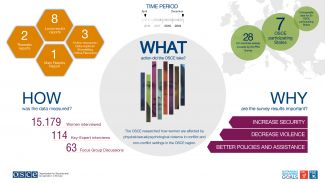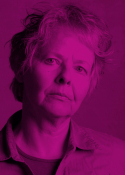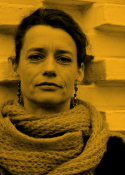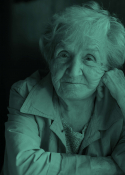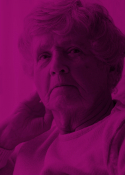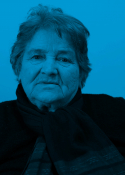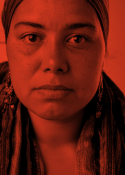I want Information
About the OSCE-led Survey on the Well-being and Safety of Women
What is the report about?
This report presents the cross-regional, comparable findings of the OSCE-led Survey on the Well-being and Safety of Women, which was implemented in 2018 in Albania, Bosnia and Herzegovina, Montenegro, North Macedonia and Serbia, Moldova[1] and Ukraine[2] The research was also conducted in Kosovo.[3]
The OSCE-led survey was undertaken with the goal of providing comparable data on different forms of violence women experienced in their childhood and throughout the course of their lives. The research examined violence that women experience in conflict and non-conflict settings, as well as the impact violence has on women, including its lasting consequences. Questions on norms and attitudes connected to violence against women were asked to better understand the underlying causes of violence.
The OSCE-led survey reveals a number of trends and findings about the prevalence of violence against women and girls, its impact and underlying social norms and stereotypes.What are the major findings?
- Seventy per cent of women, or an estimated number of 16 million women have experienced some form of sexual harassment, stalking, intimate partner violence or non-partner violence (including psychological, physical or sexual violence) since the age of 15;
- Forty-five per cent of women, or approximately 10.2 million women have experienced sexual harassment, including harassment via the internet;
- Twenty-three per cent of women, or approximately 4.9 million women, have experienced intimate partner physical and/or sexual violence;
- Eighteen per cent of women or an estimated number of 4.4 million women have experienced physical and/or sexual violence at the hands of a non-partner.
Psychological violence is the most widespread form of intimate partner violence reported in the survey, with 60% of women who have been in a relationship experiencing this from a partner.
The survey data suggests that beliefs in female subservience, spousal obedience and silence surrounding VAWG continue to persist in the region and that those women who hold such beliefs are more likely to say they have experienced violence.
Key conclusions
Based on the detailed survey findings, the OSCE has drafted a number of key conclusions that suggest ways to recognize and respond to violence against women. These conclusions build on the Istanbul Convention and recommendations by UN bodies.
- The scale of violence against women and girls in the area covered by the survey calls for enhanced efforts to implement legislation and improve action plans that will address all forms of violence experienced by women and girls.
- The survey clearly finds that all women, regardless of their economic or social status, can experience violence, but some groups of women are at a higher risk. These risks include being poor, economically dependent or having children.
- The characteristics and behaviour of perpetrators also need to be
taken into consideration as possible risk factors contributing to intimate partner violence. - Violence has a severe physical and psychological impact, and women in the surveyed locations suffer from health problems as a result of their experiences of violence.
- Based on the data gathered, it is clear that women do not report the vast majority of incidents to the police and that they rarely seek support from other institutions.
- Barriers to seeking help are rooted in attitudes that silence women and protect abusers and also in women’s lack of trust in the authorities to help and protect them.
- The data collected illustrates that a majority of women do not know what to do if they experience violence and that they are not aware of local specialized organizations offering support.
[1] The Transdniestrian region has not been covered by the survey. However, one focus group discussion was held with women from this region.
[2] The sample in Ukraine does not cover the Autonomous Republic of Crimea or non-government-controlled areas in the Donetsk and Luhansk regions. The survey was carried out on a sample representative of the adult population of women (2,048 women aged 18–74), including 298 women living close to the contact line in the Donetsk and Luhansk regions, in an effort to better understand how conflict affects violence against women.
[3] All references to Kosovo, whether to the territory, institutions or population, in this text should be understood in full compliance with United Nations Security Council Resolution 1244.
How can OSCE participating States use the data from the survey?
- Inform policies, strategies and action plans at the national and local levels
- Use the data for the development and implementation of national strategies and action plans, like national gender-equality plans, plans for combating violence against women and national action plans on UNSCR 1325
- The survey data and research contain relevant information for a wide range of ministries, including on social policy, justice, interior affairs, defence, health and education
- Present and discuss data within co-ordination bodies and working groups on gender equality and combating gender-based violence, as well as on the security and defence sector and the armed forces, in parliamentary working groups and caucuses
- Inform gender-responsive budgeting at the municipal, provincial and national level
- For monitoring and reporting on international commitments (if applicable):
- Reports to the CEDAW Committee
- Beijing Platform for Action
- National action plans on UNSCR 1325
- Sustainable Development Goals (Goal 5 and Goal 16)
- GREVIO/Istanbul Convention
- European Gender Equality Index
- NATO reporting requirements
- Include data and research findings in communication and awareness-
raising activities
- Further research using the OSCE-led survey data set
- Analyse differences in the prevalence, reporting and impact of violence against women at the subnational level and develop specific recommendations at that level.

